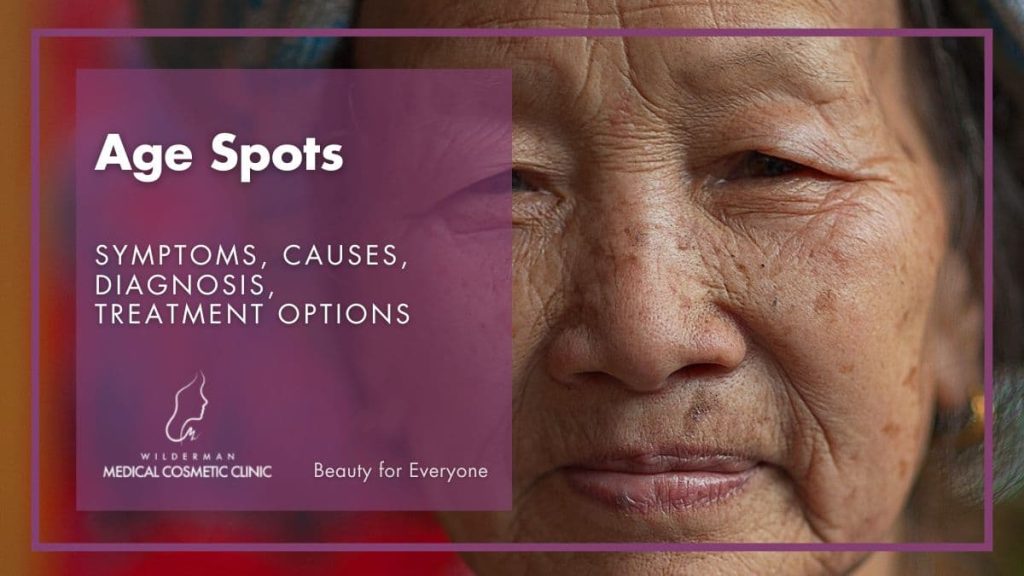Age Spots
Symptoms, Causes, Diagnosis, Treatment options
In light of the comprehensive exploration of age spots, including their symptoms, causes, and a plethora of treatment options ranging from topical solutions to advanced procedures such as Morpheus8, are you aware of innovative strategies that could further enhance our approach to these common skin changes?
Age spots, also known as liver spots or solar lentigines, are common skin blemishes that often develop as a result of prolonged sun exposure.
While they pose no serious health risks, age spots can be a cosmetic concern for many individuals.

Get immediate answers about possible treatment options tailored for you, expected results, and much more.
- Expert Diagnosis
- Customized Treatment Plans
- No Obligation
- Comfort and Privacy
- Immediate Answers
What are age spots?
Age spots are flat, brown, or grayish patches that typically appear on sun-exposed areas of the skin, such as the face, hands, arms, and shoulders.
They usually range in size from small freckles to about half an inch in diameter.
Although age spots can affect people of all skin types, they are more prevalent among those with fair skin and tend to become more pronounced with age.
Symptoms of age spots
The primary symptom of age spots is the appearance of flat, discolored patches on the skin. These patches are usually tan, brown, or black and have well-defined edges.
Age spots do not cause any pain or itching, and they do not become raised or change in texture over time.
Causes of age spots
- Sun exposure/tanning beds: The main cause of age spots is prolonged exposure to ultraviolet (UV) radiation from the sun or artificial tanning devices. UV radiation stimulates the production of melanin, the pigment responsible for giving color to the skin. Over time, this increased melanin production can lead to the formation of age spots.
- Age: Age spots are more common in older individuals, hence the name. As we age, our skin becomes less able to regenerate and repair itself, making it more susceptible to the cumulative effects of sun exposure.
- Fair skin: People with lighter skin tones are generally more prone to developing age spots. This is because their skin contains less melanin, providing less natural protection against UV radiation.
- Genetics: There may be a genetic predisposition to developing age spots. If your parents or close relatives have age spots, you may be more likely to develop them as well.
- Hormonal changes: Hormonal fluctuations, such as those occurring during pregnancy or with the use of hormonal medications, can increase the risk of developing age spots. This is why age spots are sometimes referred to as “liver spots,” although they are unrelated to liver function.
- Medications and chemicals: Certain medications and chemicals can make the skin more sensitive to UV radiation, increasing the likelihood of age spots. Examples of these include certain antibiotics, anti-inflammatory drugs, and perfumes or cosmetics containing fragrance oils.
Diagnosis of age spots
- Visual examination: Age spots are typically diagnosed through a visual examination by a dermatologist or other healthcare professional.
- Skin biopsy: In some cases, a skin biopsy may be performed to rule out other conditions. During a biopsy, a small sample of the affected skin is taken and examined under a microscope to confirm the diagnosis.
Treatment options for age spots
While age spots do not require treatment for medical reasons, many individuals seek treatment for cosmetic reasons. Several treatment options are available, including:
- Topical creams: Over-the-counter or prescription creams containing ingredients such as hydroquinone, retinoids, corticosteroids, tretinoin, azelaic acid, or kojic acid may help fade age spots over time. These creams work by lightening the skin and reducing the production of melanin.
- Cosmeceuticals: Certain skincare products, such as serums or creams containing ingredients like vitamin C, retinol, alpha hydroxy acids (AHAs), or niacinamide, can help reduce the appearance of age spots when used consistently over time.
- Chemical peels: In addition to mild chemical peels, there are stronger chemical peel options, such as medium or deep peels. These involve the application of stronger chemical solutions that penetrate deeper into the skin, effectively removing damaged skin cells and reducing the appearance of age spots.
- Cryotherapy: This treatment involves the use of liquid nitrogen to freeze the aged spots, causing the skin to peel off. As the treated area heals, new skin forms and the appearance of age spots may fade. Cryotherapy is a quick procedure typically performed in a dermatologist’s office.
- Laser therapy: Laser treatment uses intense light energy to target and break up the pigment in age spots. The laser energy is absorbed by the melanin, leading to the gradual fading of age spots. Multiple sessions may be required for optimal results, and there may be temporary redness or swelling after the procedure.
- Intense pulsed light (IPL) therapy: IPL therapy uses high-intensity light to target and break down the pigment in age spots. The light energy is absorbed by melanin, causing it to fragment and fade. Like with laser therapy, multiple sessions may be required for optimal results.
- Microdermabrasion: This treatment involves exfoliating the outermost layer of skin using a handheld device that sprays tiny crystals onto the skin and then suctions them away. Microdermabrasion can help lighten age spots and improve overall skin texture and tone.
- Dermabrasion: Similar to microdermabrasion, dermabrasion involves removing the outer layer of skin. However, it uses a more intensive method, such as a rotating brush or diamond-tipped instrument, to resurface the skin and reduce the appearance of age spots.
- Fractional laser resurfacing: This treatment uses laser technology to target the deeper layers of the skin, stimulating collagen production and promoting skin rejuvenation. It can help reduce the appearance of age spots and improve overall skin texture.
- Radiofrequency (RF): Radiofrequency (RF) treatment is a non-invasive cosmetic procedure that utilizes radiofrequency energy to heat the deeper layers of the skin. Controlled heating of the skin can target and break up the pigmented cells responsible for age spots. Additionally, RF treatment causes stimulation of collagen production, which can lead to skin tightening and a reduction in the appearance of age spots.
- Microneedling: Microneedling is a minimally invasive cosmetic procedure that can be used to address age spots. It involves the use of a handheld device called a derma roller or a mechanical pen with tiny, fine needles on its surface. The controlled injury produced by these needles triggers the skin’s regenerative response, leading to the shedding of damaged and pigmented skin cells. Additionally, microneedling stimulates increased collagen production, which can help even out skin tone and texture, reducing the visibility of age spots.
- Morpheus8: Morpheus8 is a cutting-edge cosmetic treatment that combines microneedling with radiofrequency (RF) energy to target age spots and other skin concerns. It targets the underlying pigmented cells and promotes their gradual fading. RF energy heats the deep layers of the skin, causing controlled damage and triggering the body’s natural healing response; this process helps to break down excess pigmentation and stimulate collagen production, resulting in a more even skin tone and diminished age spots.
Remember, each treatment option has its benefits, considerations, and potential side effects. It is essential to consult with a qualified dermatologist or healthcare professional to determine the most appropriate treatment for your specific needs and to ensure proper application and safety.
Tips for prevention
Preventing age spots is often more effective than treating them.
Here are some tips to minimize the risk of developing age spots:
- Sun protection: Apply good quality sunscreen with a high SPF regularly, wear protective clothing, and seek shade during peak sun hours.
- Sun avoidance: Limit your exposure to direct sunlight, especially during midday when the sun’s rays are the strongest.
- Use broad-brimmed hats and sunglasses: These accessories provide additional protection for the face and eyes.
- Avoid tanning beds: Artificial tanning devices emit harmful UV radiation and can contribute to the development of age spots.
- Moisturize: Keep your skin well-hydrated to maintain its overall health and minimize the appearance of age spots.
Conclusion
Age spots are a common skin condition that often results from long-term sun exposure. While they are harmless, many people seek treatment for cosmetic reasons.
Understanding the causes, symptoms, diagnosis, treatment options, and prevention tips associated with age spots can help individuals take appropriate measures to maintain healthy, youthful-looking skin.
Remember, protecting your skin from the sun and adopting a comprehensive skincare routine is key to reducing the likelihood of developing age spots and helping to promote overall skin health.
Reference
Mayo Clinic. (Feb 11, 2022). Age Spots (Liver Spots): Diagnosis and Treatment. Retrieved from https://www.mayoclinic.org/diseases-conditions/age-spots/diagnosis-treatment/drc-20355864 (Accessed Jun28, 2023).
Healthline. (Updated on May 19, 2023). Age Spots (Liver Spots): Treatment and Home Remedies. Retrieved from https://www.healthline.com/health/age-spots#treatment (Accessed Jun28, 2023).
Medical News Today. (Oct 9, 2018). Age Spots: Causes, Symptoms, and Treatment. Retrieved from https://www.medicalnewstoday.com/articles/323287#treatment (Accessed Jun28, 2023).
Cleveland Clinic. (Updated on Aug 17, 2021). Liver Spots (Solar Lentigines). Retrieved from https://my.clevelandclinic.org/health/diseases/21723-liver-spots (Accessed Jun28, 2023).
American Academy of Dermatology Association. (Updated on Sep 28, 2021). Get Rid of Age Spots and Skin Discolorations. Retrieved from https://www.aad.org/public/cosmetic/age-spots-marks/get-rid-spots (Accessed Jun28, 2023).
Other skin conditions that may be of interest
Skin Laxity: A common skin concern – Skin laxity is a common concern that many individuals experience as they age. It is characterized by a loss of firmness, elasticity, and resilience in the skin, leading to a less …
Sagging Skin – As we age, one of the most common concerns we face is sagging skin. The loss of elasticity and firmness can affect various parts of our body, including the face, neck, arms, and abdomen. Sagging skin can be attributed to …
Stretch Marks: Causes, Treatments, Prevention – Stretch marks, also known as striae, are a common skin condition that affects both men and women. They often appear as visible lines on the skin, typically on …
Spider Veins and Broken Capillaries – Spider veins and broken capillaries are common vascular conditions that affect a significant number of people. While they are typically harmless, they can cause cosmetic concerns for …
Oily Skin – Oily skin is a common dermatological condition characterized by excess sebum production, which can lead to a shiny, greasy appearance and potential skin issues such as acne breakouts and clogged pores. While it can be …
Smoker’s lines: A real connection to smoking? – Smoker’s lines, also known as lip lines, lipstick lines, or perioral wrinkles, are fine lines that develop around the mouth and lips. These lines can be unsightly and may contribute to …
Acne Scarring: Causes, Treatment, Prevention – Acne is a common skin condition that affects millions of people worldwide, causing physical and emotional distress. In some cases, acne can leave behind unsightly scars, further impacting …
Dark Under-Eye Circles – Dark under-eye circles can be frustrating and make you appear tired or older than you actually are. They are a common cosmetic concern that affects people of all ages. We will explore what …
Stay Ahead of the Beauty Curve
Beyond Beauty: Elevate Your Routine with Insider Tips and Breakthroughs – Subscribe Now!
Transform your beauty routine into something extraordinary!


